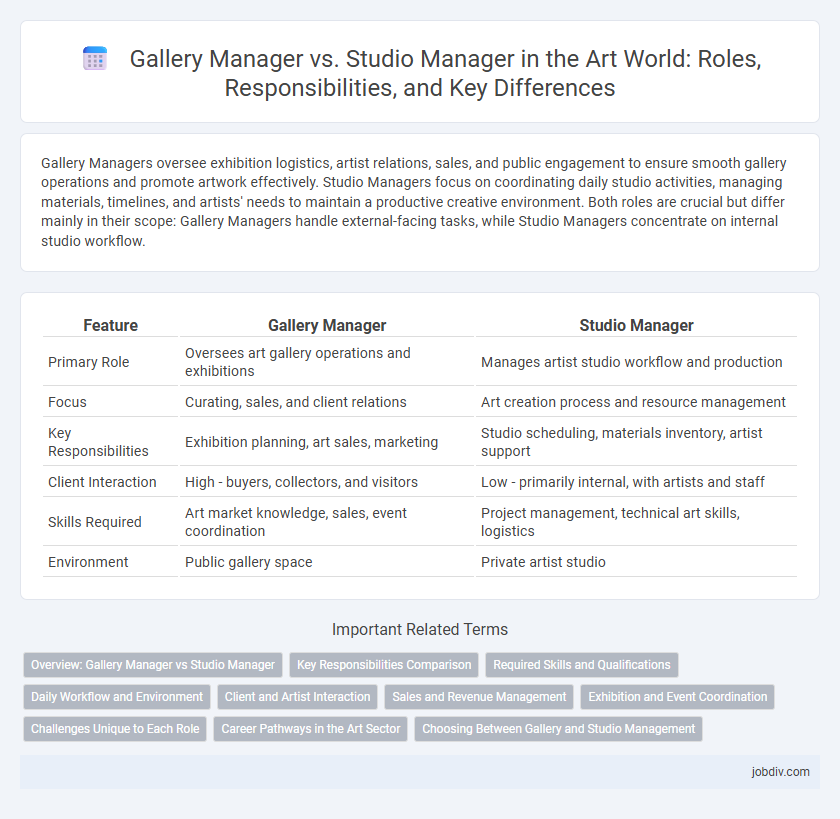Gallery Managers oversee exhibition logistics, artist relations, sales, and public engagement to ensure smooth gallery operations and promote artwork effectively. Studio Managers focus on coordinating daily studio activities, managing materials, timelines, and artists' needs to maintain a productive creative environment. Both roles are crucial but differ mainly in their scope: Gallery Managers handle external-facing tasks, while Studio Managers concentrate on internal studio workflow.
Table of Comparison
| Feature | Gallery Manager | Studio Manager |
|---|---|---|
| Primary Role | Oversees art gallery operations and exhibitions | Manages artist studio workflow and production |
| Focus | Curating, sales, and client relations | Art creation process and resource management |
| Key Responsibilities | Exhibition planning, art sales, marketing | Studio scheduling, materials inventory, artist support |
| Client Interaction | High - buyers, collectors, and visitors | Low - primarily internal, with artists and staff |
| Skills Required | Art market knowledge, sales, event coordination | Project management, technical art skills, logistics |
| Environment | Public gallery space | Private artist studio |
Overview: Gallery Manager vs Studio Manager
Gallery managers oversee art exhibition spaces, handling artist relations, sales, marketing, and event coordination to enhance visitor experience and revenue. Studio managers focus on managing the day-to-day operations within artists' studios, including supply procurement, scheduling, and facilitating creative workflows. Both roles require strong organizational skills, but gallery managers emphasize public engagement while studio managers prioritize supporting artistic production.
Key Responsibilities Comparison
Gallery managers oversee exhibition curation, artist relations, and sales operations, ensuring the seamless presentation and commercialization of artworks. Studio managers focus on coordinating daily studio activities, managing art supplies, equipment maintenance, and supporting the creative process for artists. Both roles require organizational skills, but gallery managers prioritize public engagement and commercial strategy, while studio managers emphasize production efficiency and artist workflow.
Required Skills and Qualifications
A Gallery Manager requires strong customer service skills, expertise in art curation, and proficiency in sales and marketing to promote exhibitions and artworks effectively. Studio Managers must have technical knowledge of art production processes, project management skills, and the ability to coordinate artists and resources efficiently. Both roles demand excellent communication and organizational abilities, but the Gallery Manager leans more toward client relations and business acumen, while the Studio Manager emphasizes operational oversight and creative workflow management.
Daily Workflow and Environment
Gallery Managers oversee daily gallery operations, including coordinating exhibitions, managing sales, and engaging with collectors and visitors to ensure a smooth visitor experience. Studio Managers focus on organizing artists' schedules, maintaining studio equipment, and facilitating the creation process by providing logistical support and managing materials. The gallery environment is client-facing and sales-driven, while the studio environment is production-focused and collaborative among artists and support staff.
Client and Artist Interaction
Gallery managers prioritize client relationships by organizing exhibitions, facilitating art sales, and curating experiences tailored to collectors and visitors. Studio managers focus on supporting artists directly through scheduling, resource allocation, and coordinating studio operations to optimize creative productivity. Effective client and artist interaction depends on the gallery manager's public engagement and the studio manager's behind-the-scenes artist support.
Sales and Revenue Management
Gallery Managers concentrate on maximizing sales and revenue by curating exhibitions that attract high-value collectors and optimizing pricing strategies for artworks. Studio Managers focus on managing production schedules and artist resources, indirectly supporting sales by ensuring timely delivery and quality of artworks. Effective collaboration between both roles enhances overall revenue by aligning creative output with market demand.
Exhibition and Event Coordination
Gallery Managers oversee exhibition planning, coordinating artists, curators, and marketing to ensure seamless event execution and optimal visitor engagement. Studio Managers handle the logistical aspects within artists' workspaces, facilitating materials, schedules, and workflow to support creative production without directly managing public exhibitions. Both roles require strong organizational skills, but Gallery Managers prioritize public event coordination while Studio Managers focus on behind-the-scenes studio operations.
Challenges Unique to Each Role
Gallery managers face challenges such as coordinating exhibitions, managing art sales, and maintaining relationships with collectors and artists, requiring strong marketing and sales expertise. Studio managers deal with overseeing artists' creative processes, managing supplies and equipment, and coordinating project timelines, emphasizing operational efficiency and supporting artistic production. Each role demands specialized skills to navigate the distinct demands of commercial gallery operations versus creative studio environments.
Career Pathways in the Art Sector
Gallery managers oversee exhibition curation, sales, and artist relations, often requiring expertise in art history and marketing, while studio managers focus on production logistics, artist support, and resource coordination, demanding skills in project management and technical art knowledge. Career pathways for gallery managers typically involve progressing through roles in art sales, curatorial assistance, or event coordination, with opportunities to advance to director positions within galleries or museums. Studio managers may advance by gaining experience in large-scale production studios or artist residencies, potentially moving into studio ownership or production consulting roles.
Choosing Between Gallery and Studio Management
Choosing between gallery management and studio management requires understanding their distinct roles: gallery managers focus on curating exhibitions, promoting artists, and driving sales within a commercial space, while studio managers oversee daily studio operations, artist schedules, and production logistics. Gallery management demands strong skills in marketing, client relations, and event coordination to maximize artwork visibility and revenue. Studio management prioritizes operational efficiency and resource allocation to support the creative process and meet artistic deadlines.
Gallery Manager vs Studio Manager Infographic

 jobdiv.com
jobdiv.com